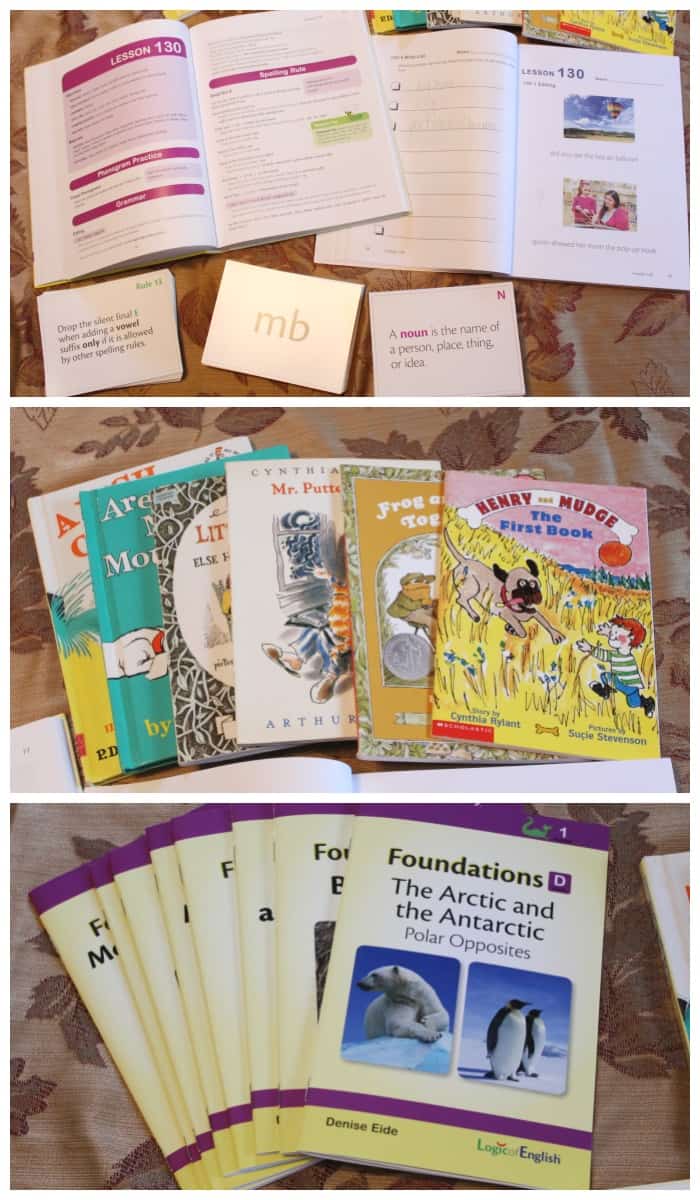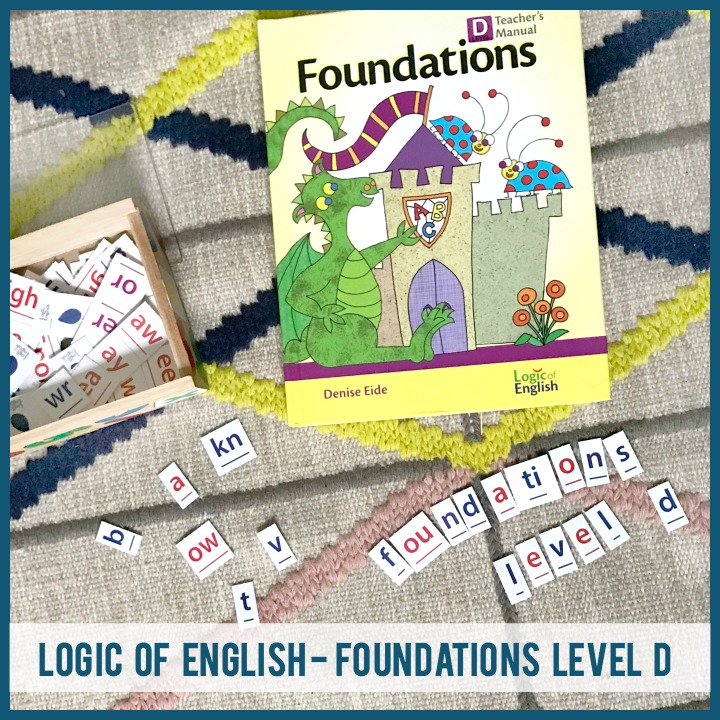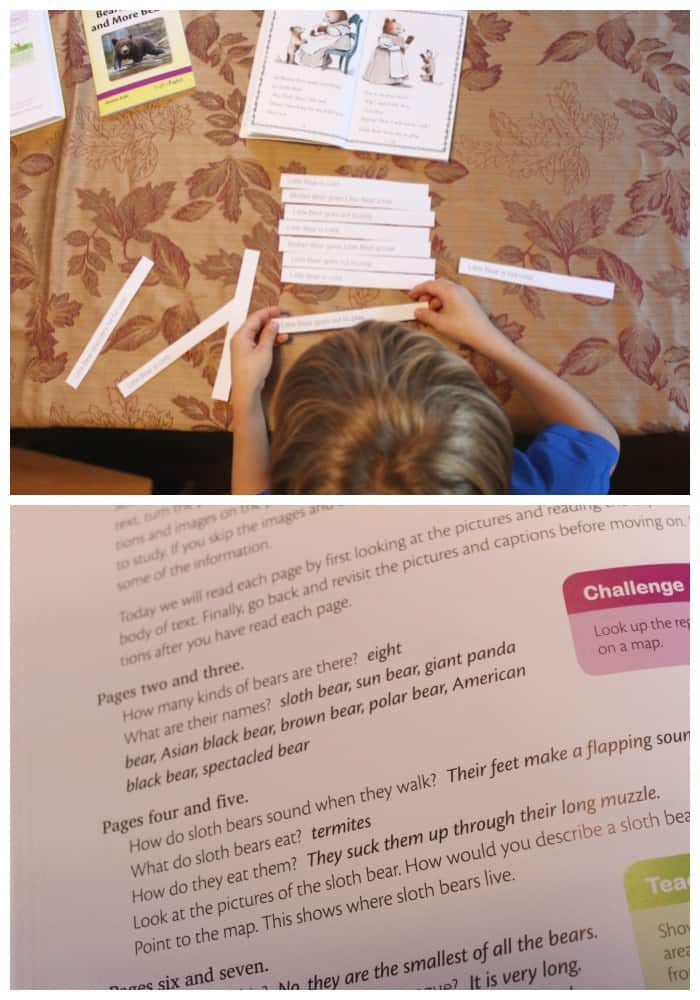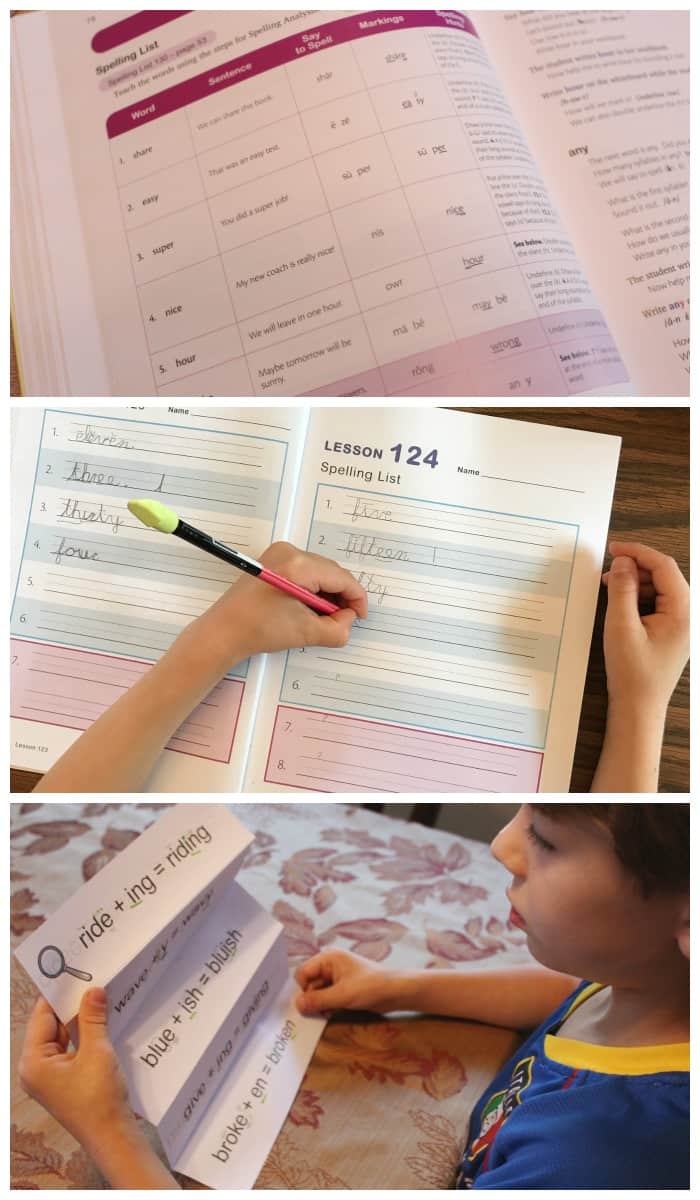I honestly can’t imagine teaching my children how to read (and write) without The Logic of English program. Our school year for my second grader began with us cracking open Foundations Level D with great excitement. And I’ve once again partnered with the The Logic of English program to review Foundations Level D, which is helping our family build strong readers!

Sponsored post.
Build strong readers with Logic of English Foundations Level D
We started with Foundations Level A (read the review!) two years ago, and progressed through Level B and Level C (read the review!). I can’t say enough good things about this complete and thorough phonics, spelling, reading, writing, and handwriting program. Read my previous reviews to get the full picture, but truly, Logic of English has been a shining star in our homeschool days.
To recap, Foundations Level A introduces and develops basic phonogram awareness. Level B introduces reading short sentences and adding multi-letter phonograms. Level C develops writers up to short paragraphs, includes spelling rules, and multi-syllable words.
In Logic of English Foundations Level D, the learner accelerates in reading and writing understanding. Armed with a “deep bench” of phonogram sounds and spelling skills from previous levels, they progress into reading books and learning detailed writing organization and structure.

For Level D, we use most of the materials from previous levels (with the exception of the handwriting reference card and tactile cards) and add a few new pieces:
Previous level materials:
- Basic Phonogram Flash Cards
- Phonogram and Spelling Rule Quick Reference – I use this daily!
- Spelling Analysis Card
- Phonogram Game Cards
- Phonogram Game Tiles
- Student Whiteboard
Level D materials added:
- Teacher’s Manual D
- Student Workbook D
- Foundations D Readers and 13 real children’s books!
- Knitting Knights: Beyond the Sounds of ABC – see my review here!
- Advanced Phonogram Flash Cards
- Spelling Rule Flash Cards
- Grammar Flash Cards
How we The Logic of English in our homeschooling

In the other Foundations levels, I could complete a full lesson in one to two days. I find the depth of reading and writing in Level D requires a few more days to cover material in depth. We complete about one lesson per week. I generally spend about twenty to twenty-five minutes instructing, four days a week. I break it up like this (same order as in the teacher manual):
- Day 1 – Phonograms and Grammar
- Day 2 – Spelling and Handwriting (we do various copywork activities)
- Day 3 – Reading Comprehension
- Day 4 – Writing and Games
If I need to consolidate for a short week, I can and do. We complete Review lessons in one day, and I use that as my assessment. Sometimes I’ll take the next day to reteach items that were shaky in the review.
My favorite aspects of Foundations Level D

Teacher Manual – The teacher manual is incredibly well-structured and easy to use. The spelling and reading comprehension sections have a “script” to assist instruction. All the manuals follow the same format, so once I got used to Level A, this part of the teaching process was easy. I love the Teacher Tip sidebars that give me juicy nuggets to share with my son (and I get to sound incredibly smart, like when I tell him that hour is a word we borrowed from the French!)
Hands-on activities – Kids have opportunity to use their differentiated learning abilities: playing games like tic-tac-toe, cutting and pasting, physical activities, using tactile props, hide and seek with word cards to name a few.
Game review activities – Games make learning phonograms exciting for kids! Bingo, card games (with the phonogram game cards), matching, relays, physical activities… just a few of the games we’ve played in the first ten lessons! I love how each lesson has a different spin on how to review – we are never, ever bored!

Real children’s books! – My oldest has been reading actual children’s books fluently since about the end of Level B (that’s how amazing this program is!). But now children’s books are part of our learning, and we’re having fun reading aloud with expression and thinking through meaning together. Books like Little Bear, Are You My Mother? and Should I Share My Ice Cream? have been favorites for years, and now my son is thrilled he can read and discuss these stories in our “class.”

The Say to Spell method – I thought I’d dread slogging through long lists of spelling words that had no bearing on our lives. However, Logic of English takes an entirely different approach than I remember from grammar school. They focus on high frequency words, and use the Say to Spell method where the teacher articulates the sounds of words that get lost in normal speaking. This helps students create a mental “picture” of how a word should be spelled. This is particularly helpful when teaching children to spell words with a schwa (lazy sound), or other oddly pronounced words. I love how the spelling always refers back to the phonograms we’ve learned and asks students to recall whether a phonogram is using a long / short sound or the first, second, or third (etc) sound.
Incremental writing instruction – I’m a writing teacher by trade. So I have my own ideas about how to instruct young writers. While I personally like to see writers spending more time daily on writing, I love the writing mini-lessons and methods in Level D. Each writing skill is connected to reading or spelling. For instance, creating a book of opposites after reading Polar Opposites. Making a book of numbers to practice spelling numbers. Or making lists and adding captions after reading Little Bear (and his list of wishes) and the nonfiction Bears book. Writing instruction in Level D follows a clear sequence of modeling with mentor texts, guided practice, and independent practice, which I completely espouse as a writing teacher.
But the real reason I love The Logic of English Level D…
…Is because it brings me SO MUCH JOY to teach my own child how to read and write successfully. As I am writing this, (and whenever I talk about The Logic of English to other moms!) my heart is filled with happiness thinking about how easily we have flowed reading and writing! We have fun together, create mini writing pieces, and celebrate each success!
I never worry about gaps in his understanding, or what I’ll teach next. I spend little time prepping and planning, and most of my time enjoying sharing the love of language with my children (I say children, because this year, I have another little one who just started Level A, so it’s been fun working out of two levels at the same time!).
I truly think without this program I would have floundered trying to get through the multiple components of Language Arts instruction. There’s so many “moving parts” (Reading, Spelling, Grammar, Vocab, Fluency, Comprehension, Writing, Handwriting). Yet The Logic of English balances each of them in a way that makes teaching a breeze and learning a happy time for both this mama and son.
Check out The Logic of English on their website, on Facebook, and on Twitter.
Are you struggling with language arts instruction? Tell me what’s going on and ask me any questions about this program and I will happily answer!

Thanks to The Logic of English for providing Level D materials for this review. All opinions are 100% my own and honest. Affiliate links have been used in this post and purchases made after clicking on these links may generate a small commission for me.


Trisha W.
Monday 13th of November 2017
Your son has beautiful penmanship. I'm curious, does he prefer cursive to printing?
Julie Kieras
Tuesday 14th of November 2017
He loves to mix it up - but I know that at heart he is very tickled with himself that he can write in cursive! :)